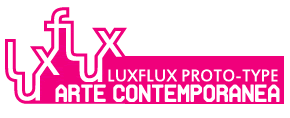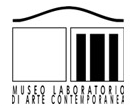Bertram Niessen: First of all I’ld like to ask you something about your relationship with collective work. You have collaborated with different kinds of artists/programmers (Lieberman, Blonk, La Barbara, Gibbons, Shakar and others); more generally speaking, some of your projects require a staff of technicians. How do you interact with all this people in the project phase and in the performing phase?
Golan Levin: The production of a large-scale electronic media artwork often requires a lot of people, and in particular, a lot of different professionals with highly developed specializations. In this sense, producing media art can have more in common with film-making, than with the old Romantic notion of artistic activity, like a tormented painter isolated in a garret. Every artist who works in electronic media must find his or her own solution to this demanding problem. I know some artists who have essentially become conceptualizers and project managers — all of the engineering and construction is then conducted by people whom they employ. Some other artists only take on projects where they can control every aspect of the work; these artists have to accept the limitation in the scale of what they can accomplish on their own.
I share the philosophy of my former professor, John Maeda, who feels that a media artist should also be a completely self-sufficient engineer. This attitude is absolutely essential in teaching students to become self-sufficient. But unfortunately it’s just not practical for artists who want to make larger projects, and so it becomes important to learn how to divide work among several people. Ultimately I try to strike a balance that keeps me involved in the technical and artistic details, so most of my projects have been collaborations with small numbers of people. I especially enjoy working with artist/programmers whose skills are similar to mine; Zach Lieberman is a significant example. When this happens, it’s possible to really share in both the vision and also the implementation of a project. Of course, sometimes one really does need to secure the collaboration of people with entirely different skill-sets. Our “Messa di Voce” performance, for example, was conceived around the idea that we would create software to complement the voices of two experimental vocalists — Joan La Barbara and Jaap Blonk. Their voices and compositional ideas were the core of the project.
B.N.: Here in Italy we don’t have big computer business. So there aren’t laboratories who investigate things like links beetwen performing art & computers. Most of the research and innovation in this field is carried on by small indipendent art collectives related to the political and artistic underground scene, often to the hacker’s one. Do you have any relationship or interest in this area? (Axis seems to suggest a positive response…)
G.L.: You have great new-media artists in Italy . The Bolognese group 0100101110101101.org is an example. Yes, they are a small collective from the underground scene; it’s true. But their projects are nevertheless quite technologically sophisticated — consider their Vopos project in which they arranged to have themselves tracked by satellites for a year. Most importantly, however, their projects are ideologically and tactically sophisticated. Artwork with that degree of significance never comes out of research laboratories. The 01’s do not have the luxury to rely on some fancy research-lab wizardry to make their projects seem “cool”, so they have to succeed by the strength of their concepts. Likewise, in the area of performance, consider the Societas Raffaelo Sanzio from Cisena. Once again, their projects are technically sophisticated. But they succeed by the strength of their incredibly rigorous aesthetics. These artists prove that a new-media artist does not need to be supported by a research laboratory, or born in one.
B.N.: In your MS thesis you talk about “the idea of an inexhaustible, infinitely variable, time-based, audiovisual “substance” which can be gesturally created, deposited, manipulated and deleted in a free-form, non-diagrammatic image space.” I found this metaphor really intersting because it seems related to an hyper-uranical vision of art; is it intentional or not?
G.L.Yes, my ultimate objective was to create a hypothetical substance which could assume the form of any sound and any image simultaneously. Such a meta-substance would be a morphological wonder in the extreme. In a sense this medium already exists, in the pixels and bytes of digital imagery and audio produced by computers. The significant question is how to expressively control such a substance in real-time. This question has been at the core of my research and to study it I have considered interfaces based on the mouse, the hand, the voice, the whole body, and soon, the eyes and face.
B.N.: More generally speaking, software based art is probably the kind of art more strictly related to metaphors. what about your work by this point of view?
G.L.: I consider my work abstract, non-allegorical, and non-metaphoric. I try to create impressions which are perceived and appreciated entirely within the sensorium. If the interactant or observer of my work conceives of their experience in narrative or symbolic terms, that’s their business, and they are certainly welcome to do so, but I don’t encourage it. To make work which satisfies the sensorium, I must rely on a vocabulary of fundamental impressions which conform well to our pre-existing perceptual experiences and embodied cognition. For this Nature is the greatest master. When I do copy from Nature, I prefer to copy its behaviors and logics of response rather than its visual appearances.
B.N.:In other interviews you talk about the fear that you feel going to perform on stage for the first time: “will everithing be ok?”, “will my computer crash?”… but what about the positive feelings related to the live performance?
G.L.: Wondering “will my computer crash” is not simply fear. It also contains the thrill of gambling. That feeling is both positive and negative combined.
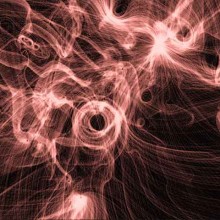
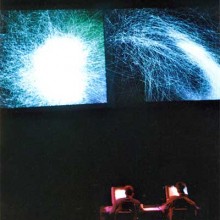
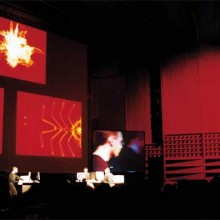
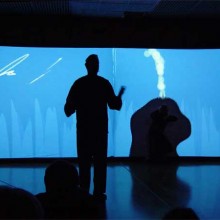
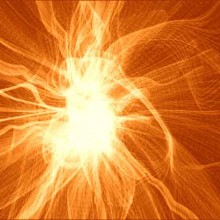
Dall’alto:
Golan Levin, Scribble, 2000-2003
GolanLevin, Floo, 2001
Golan Levin, Messa di Voce, 2003-2005
Golan Levin, Scribble, 2000-2002
Golan Levin, Floo-red, 2001
